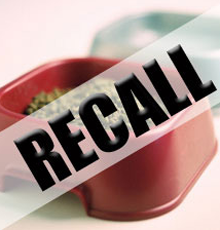FDA Recalls Several Brands of Dry Dog Foods

The FDA is alerting pet owners and veterinary professionals about several recalls of potentially dangerous dry dog foods.
The FDA has recalled nine dry dog food brands after receiving complaints that the dogs consuming these brands experienced vitamin D toxicity.
Experts say symptoms to look for in your pet include drooling, vomiting, lethargy and loss of appetite.
Consuming foods with toxic levels of vitamin D can lead to kidney failure or other life-threatening side effects, veterinary professionals say.
Veterinary professionals recommend looking for an AAFCO label on the side of pet food bags when choosing a brand to feed your pet. This label indicates that there has been a feeding trial, which guarantees that the food is safe for your pet’s consumption.
The following dog food brands are a list taken directly from the FDA of items affected by the recall:
Sunshine Mills, Inc.
Old Glory Hearty Turkey and Cheese Flavor Dog Food
UPC 0-70155-14297-9 – 12.75 lb. bag
TC3 29 October 2018
TA1 30 October 2018
TA2 30 October 2018
TC1 30 October 2018
TC2 30 October 2018
TC3 30 October 2018
Evolve Chicken & Rice Puppy Dry Dog Food
UPC 0-73657-00862-0 – 14 lb. bag
UPC 0-73657-00863-7 – 28 lb. bag
Sportsman’s Pride Large Breed Puppy Dry Dog Food
UPC 0-70155-10566-0 – 40 lb. bag
UPC 0-70155-10564-0 – 40 lb. bag
Triumph Chicken & Rice Recipe Dry Dog Food
UPC 0-73657-00873-6 – 3.5 lb. bag
UPC 0-73657-00874-3 – 16 lb. bag
UPC 0-73657-00875-0 – 30 lb. bag
Ahold Delhaize (firm has not yet issued recall press)
Nature’s Promise Chicken & Brown Rice Dog Food
UPC 068826718472 – 14 lb. bag
All lot codes
UPC 068826718471 – 28 lb. bag
All lot codes
UPC 068826718473 – 4 lb. bag
All lot codes
Nature’s Place Real Country Chicken and Brown Rice Dog Food
UPC 72543998959 – 5 lb. bag
All lot codes
UPC 72543998960 – 15 lb. bag
All lot codes
Kroger (12/5/18)
Abound Chicken and Brown Rice Recipe Dog Food
UPC 11110-83556 – 4 lb. bag
All lot codes
King Soopers (12/5/18)
Abound Chicken and Brown Rice Recipe Dog Food
UPC 11110-83556 – 4 lb. bag
All lot codes
UPC 11110-83573 – 14 lb. bag
All lot codes
UPC 11110-89076 – 24 lb. bag
All lot codes
ELM Pet Foods, Inc. (11/29/18)
ELM Chicken and Chickpea Recipe
UPC 0-70155-22507-8 – 3 lb. bag
D2 26 FEB 2019
TE1 30 APR 2019
TD1 5 SEP 2019
TD2 5 SEP 2019
UPC 0-70155-22513-9 – 28 lb. bag
TB3 6 APR 2019
TA1 2 JULY 2019
TI1 2 JULY 2019
ELM K9 Naturals Chicken Recipe
UPC 0-70155-22522-9 – 40 lb. bag
TB3 14 Sep 2019
TA2 22 Sep 2019
TB2 11 Oct 2019
ANF, Inc. (11/28/18)
ANF Lamb and Rice Dry Dog Food
UPC 9097231622 – 3 kg bag
Best by Nov 23 2019
UPC 9097203300 – 7.5 kg bag
Best by Nov 20 2019
Lidl (Orlando brand) (11/6/18)
Orlando Grain-Free Chicken & Chickpea Superfood Recipe Dog Food
Lidl product number 215662
TI1 3 Mar 2019
TB2 21 Mar 2019
TB3 21 Mar 2019
TA2 19 Apr 2019
TB1 15 May 2019
TB2 15 May 2019
Natural Life Pet Products (11/2/18, expanded 11/9/18)
Chicken & Potato Dry Dog Food
UPC 0-12344-08175-1 – 17.5 lb. bag
Best by dates range: December 4, 2019 through August 10, 2020
Nutrisca (11/2/18)
Chicken and Chickpea Dry Dog Food
UPC 8-84244-12495-7 – 4 lb. bag
UPC 8-84244-12795-8 – 15 lb. bag
UPC 8-84244-12895-5 – 28 lb. bag
Best by date range: February 25, 2020 through September 13, 2020
If your pet has ingested any of the above and is showing any symptoms, please contact us immediately.
Info courtesy of WKRN
- Behavior (15)
- Caring for your pet (292)
- cat (16)
- Community Events (20)
- dog (17)
- From Our Clients (15)
- Happy Tails (12)
- News (454)
- Press (53)
- Products (2)
- Questions (4)
- Recalls (1)
- Special Offers (6)
- Tips & Advice (231)
- Uncategorized (21)
- Veterinary Services (49)
